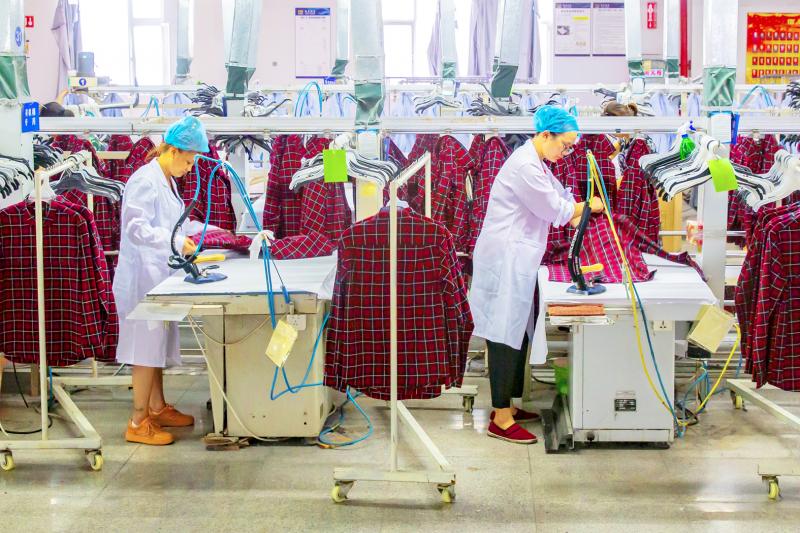Factory activity in China slipped slightly last month, according to official data published yesterday, as the country grappled with the fallout from widespread floods.
The closely watched purchasing managers’ index (PMI) is a key gauge of manufacturing activity in the world’s second-largest economy, which has largely bounced back after plunging in February due to dramatic COVID-19 measures.
However, last month that rebound slowed a little with the PMI inching down to 51.0 from 51.1 in the previous month.

Photo: AP
Zhao Qinghe (趙清河), a senior statistician at the Chinese National Bureau of Statistics (NBS), said heavy rains and floods had hit the business and production of companies in Sichuan and southwestern China.
Nomura economists had warned earlier in the month that while there was likely to be strong recovery among high-tech industries, resurgent flooding in the middle of the month “could impact both production and demand along the Yangtze River.”
China has been hit by very severe floods this summer, affecting millions of people, washing away roads and forcing the closure of some tourist sites and transport links.
Last month’s PMI was also below analyst expectations reflected in a Bloomberg poll, which forecast a climb to 51.2.
Any figure above the 50-point mark represents growth rather than contraction.
In February, the PMI plunged to 35.7 points after COVID-19 brought much of China to a standstill.
Demand was continuing to recover and exports are “gradually improving,” Zhao said. “Business expectations have improved and corporate confidence has increased.”
Non-manufacturing PMI came in at 55.2 points — up from 54.2 in July and slightly better than expected by analysts, who had predicted a flat level throughout the month.
“This could be due to the strong demand for cross-provincial leisure trips as families spend summer holidays within mainland China, because overseas travel restrictions remain mostly unchanged,” ING Bank NV chief economist for Greater China Iris Pang (彭藹嬈) said.
She added that until the coronavirus situation eases overseas and China relaxes its travel restrictions, the country will rely more on domestic spending for economic growth.
However, PMI for small companies was down to 47.7 points, down on the previous month and still in contraction territory.
“This month, over 50 percent of small companies reported insufficient market demand and over 40 percent reported capital shortage, and their production and operation still face many difficulties,” Zhao said.
Analysts were broadly positive about the outlook.
“It’s not too surprising that the manufacturing PMI has started to level off since growth in industry has already returned to its pre-virus level,” Capital Economics Ltd senior China economist Julian Evans-Pritchard said. “But with fiscal support on course to be stepped up further in the coming months, we still think there is some further upside to industrial activity.”
Investment bank HSBC expects China’s economy would grow by 5.4 percent in the third quarter year-on-year, followed by a 6.2 percent expansion in the fourth quarter, returning China’s growth to pre-COVID levels.
But some analysts fear that the recovery could stall, hurt by rising tensions between Washington and Beijing and as another wave of local COVID-19 infections returns in the winter.
Additional reporting by Reuters

The DBS Foundation yesterday announced the launch of two flagship programs, “Silver Motion” and “Happier Caregiver, Healthier Seniors,” in partnership with CCILU Ltd, Hondao Senior Citizens’ Welfare Foundation and the Garden of Hope Foundation to help Taiwan face the challenges of a rapidly aging population. The foundation said it would invest S$4.91 million (US$3.8 million) over three years to foster inclusion and resilience in an aging society. “Aging may bring challenges, but it also brings opportunities. With many Asian markets rapidly becoming super-aged, the DBS Foundation is working with a regional ecosystem of like-minded partners across the private, public and people sectors

BREAKTHROUGH TECH: Powertech expects its fan-out PLP system to become mainstream, saying it can offer three-times greater production throughput Chip packaging service provider Powertech Technology Inc (力成科技) plans to more than double its capital expenditures next year to more than NT$40 billion (US$1.31 billion) as demand for its new panel-level packaging (PLP) technology, primarily used in chips for artificial intelligence (AI) applications, has greatly exceeded what it can supply. A significant portion of the budget, about US$1 billion, would be earmarked for fan-out PLP technology, Powertech told investors yesterday. Its heavy investment in fan-out PLP technology over the past 10 years is expected to bear fruit in 2027 after the technology enters volume production, it said, adding that the tech would

YEAR-END BOOST: The holiday shopping season in the US and Europe, combined with rising demand for AI applications, is expected to drive exports to a new high, the NDC said Taiwan’s business climate monitor improved last month, transitioning from steady growth for the first time in five months, as robust global demand for artificial intelligence (AI) products and new iPhone shipments boosted exports and corporate sales, the National Development Council (NDC) said yesterday. The council uses a five-color system to measure the nation’s economic state, with “green” indicating steady growth, “red” suggesting a boom and “blue” reflecting a recession. “Yellow-red” and “yellow-blue” suggest a transition to a stronger or weaker condition. The total score of the monitor’s composite index rose to 35 points from a revised 31 in August, ending a four-month

RUN IT BACK: A succesful first project working with hyperscalers to design chips encouraged MediaTek to start a second project, aiming to hit stride in 2028 MediaTek Inc (聯發科), the world’s biggest smartphone chip supplier, yesterday said it is engaging a second hyperscaler to help design artificial intelligence (AI) accelerators used in data centers following a similar project expected to generate revenue streams soon. The first AI accelerator project is to bring in US$1 billion revenue next year and several billion US dollars more in 2027, MediaTek chief executive officer Rick Tsai (蔡力行) told a virtual investor conference yesterday. The second AI accelerator project is expected to contribute to revenue beginning in 2028, Tsai said. MediaTek yesterday raised its revenue forecast for the global AI accelerator used